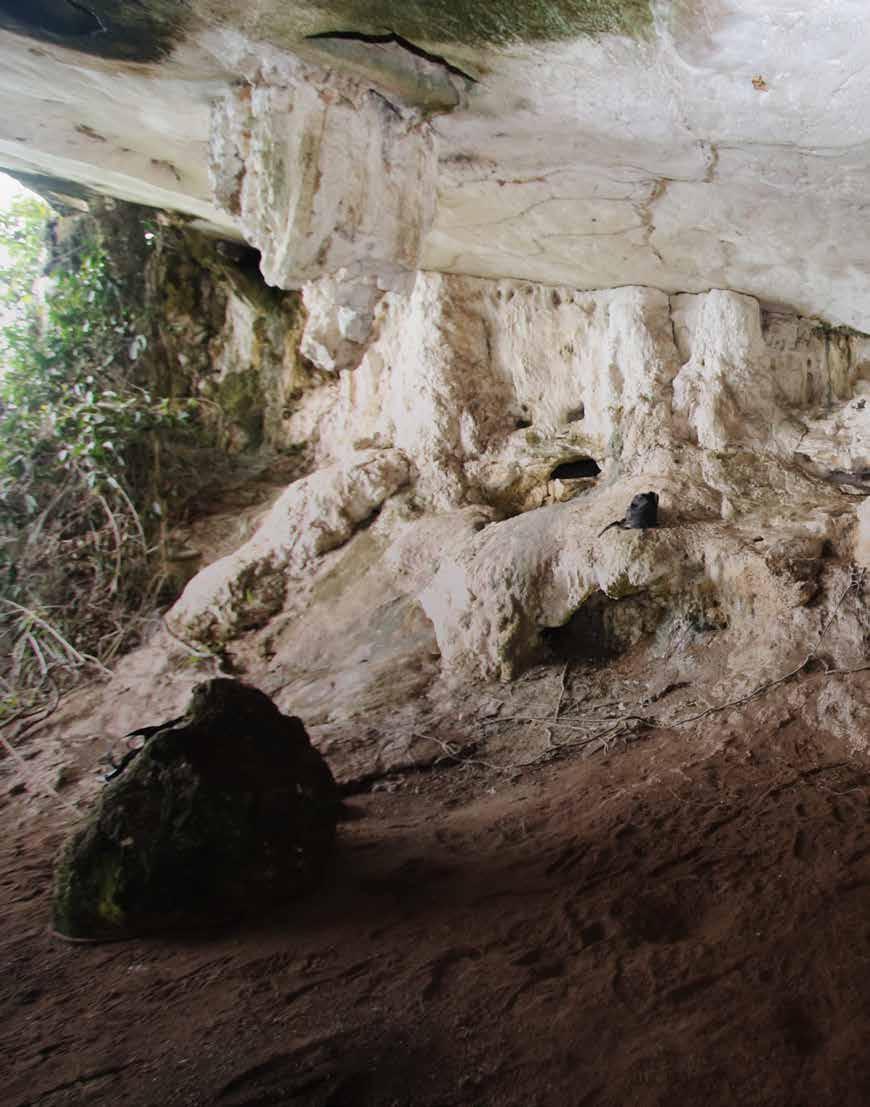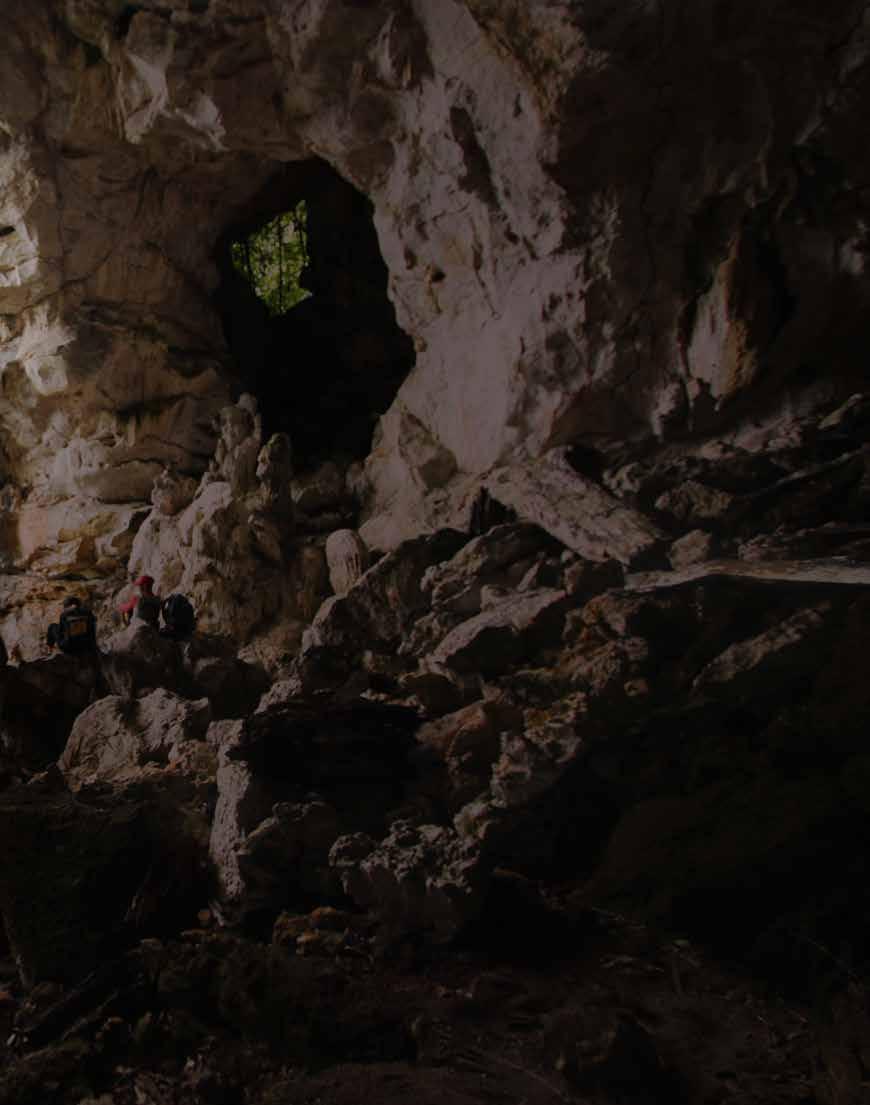
6 minute read
Sangkulirang - Mangkalihat Prehistoric Rock Art in the Heart of Kalimantan
Tewet Atas niche -
Edy Gunawan
Advertisement
Sangkulirang- Mangkalihat A sign of civilization Edy Gunawan
Prehistoric Rock Art in the Heart of Kalimantan

f t im e - E dy Gunawan Faci n g th e sco u r g e o


Karst Sangkulirang - Mangkalihat is a karst landscape located in East Kalimantan, precisely in East Kutai Regency, and stretches to Berau Regency. Karst is an area consisting of porous limestone so that water on the ground surface always seeps and disappears into the ground. Sangkulirang - Mangkalihat is surrounded by steep walls, underground caves with beautiful natural carvings, and wide green hills. This karst is rich in historical relics which are also important information regarding the existence of prehistoric humans and their activities at that time. All of that is recorded in seni cadas or rock art, namely paintings on the walls of caves or niches, cliffs, and rocks.
With the distribution of caves and rock shelters, Sangkulirang Mangkalihat is thought to have been used as a place to live by humans in the past. The use of caves and niches in the past has left traces of residence and cultural remains that are diverse and have their own uniqueness, including rock drawings made by prehistoric people. Rock images or rock art are usually expressed on cave walls and are often found in the Americas, Africa, Europe, Australia, to Asia.

In Asia, rock images are found in Malaysia, Thailand, the Philippines, and Indonesia. Rock images in the Sangkulirang - Mangkalihat karst became one of the rock image area sites that had been registered on the UNESCO Tentative List on January 30, 2015. It
Remaining pictures
Edy Gunawan
in one corner of the Tewet Atas Niche Edy Gunawan


was recorded with Ref No. 6009 with the title Sangkulirang-Mangkalihat Karst: Prehistoric Rock art Area.

There are more than 50 locations of various caves in the Sangkulirang - Mangkalihat Karst that have rock art. From the results of archaeological interpretation of the area indicates research, it is known that the paintings in changes in land cover. This change the cave are tens of thousands of years affected the Austronesian way of life, old. This karst area has information about from hunting to fishing, for example, and ancient human traces that can be seen is clearly illustrated in the rock images from hand paintings, boat drawings, and found. paintings of various types of animals that are clearly depicted on cave walls and are Based on the results of research that has said to have existed tens of thousands of been done, it is known that in addition years ago. to rock drawings, various artifacts and eco artifacts were also found which are Prehistoric estimated to have come from the period The island of Borneo, which in ancient 4000 years ago. One of the oldest animal times was part of Sundaland (a large paintings was also found in Liang Karim mainland in Southeast Asia thousands Cave and Lubang Jeriji Saleh Cave in the of years ago), is the largest island in the area of Mount Batu Sawi. According to Indonesian Archipelago. In the middle east of East Kalimantan, lies a karst area called Sangkulirang - Mangkalihat. This karst area is located upstream of five major rivers that flow into the Sulawesi Sea. In the area there are also seven giant karst mountains (Batu Aji, Stone Saws, Batu Tondoyan, Kulat Hunchback Stone, Stone Tutunambo-Pemulin, Batu Pengadan, and Batu Tabalar Ara Raya) and the vast Tutunambo Batu Putih karst courtyard. Thousands of prehistoric rock art paintings and carvings are found here, spread over 48 inland caves in seven different karst mountainous regions. Rock art painted on the ceilings, walls, and cavities of caves depends on the meaning. They depict forms such as spiritual images (zoomorphic and anthropomorphic) and images of social phenomena (equipment and weapons) that depict everyday life. Of all the rock art, hand painting is the most common element.
Maxime Aubert, an archaeologist and professor at Griffith University Autralia, the painting that is believed to be a wild bull is 40,000 years old. There is also a rock image in the form of a giant honey bee nest which has a size of 1.5 meters. In addition to beehives, there are also negative handprints which, unfortunately, have begun to be damaged and have been reached by human hands. Liang Karim Cave is only one of dozens of prehistoric sites in the Sangkulirang Mangkalihat Karst area.
Pindi Cave - Edy Gunawan
Radiocarbon dating shows that rock art at Tewet Cave in Sangkulirang Mangkalihat is 40,000 BP. This is much earlier than the Lascaux Caves (35,400 BP) and Chauvet Caves (32,000) in France previously known to be the earliest in the world.
Rock drawings and some archaeological finds in this area also show the migration of the Austronesians. During migration, Borneo’s climate and land cover change over time. Continental climate occurs when all of Sundaland is still dry (40,000–21,000 BP), followed by tropical savanna climate and island climate (12,000–7,000 BP), then followed by Tropical Rainforest (1,000 BP). Correlatively, the geological
Cultural Heritage
Karst Sangkulirang - Mangkalihat karst has many historical relics that have not been fully researched and excavated, including relics in the form of culture, history, and organisms that live in the expanse of the karst.
Rock images as cultural resources need special attention. Conservation efforts are absolutely necessary considering the threat of massive damage. In line with this, massive conservation activities were carried out and through multisectoral collaboration involving various stakeholders, especially the Regional Government of East Kutai Regency, Berau, East Kalimantan Provincial Government and other inter-ministerial. This is a necessary step to realize the sustainable management of this area as a cultural properties site. To strengthen public awareness about one of the oldest known rock images in the world, it is necessary to design interesting information on the distribution of the Sangkulirang - Mangkalihat rock images. This needs to be done through the description of various aspects of these sites, namely their location and position among other world rock images, details of the location at the site, climate and geomorphological changes that occurred and their effects on current rock images, their correlation with prehistoric migration, and threats faced today by industrial activities. An integrated multidimensional representation can make this area more familiar to many parties.
Currently, as observed from satellite imagery, industrial activities such as karst exploitation for cement production and land clearing for oil palm plantations threaten Sangkulirang - Mangkalihat. Various efforts were made to preserve these sites, ranging from the establishment of local regulations to the big step to propose them as one of the UNESCO World Cultural Heritage.
It is hoped that with the designation of Sangkulirang - Mangkalihat as a World Heritage by UNESCO, efforts to preserve rock images and the environment, as well as other cultural heritage of ancient human history, can be guaranteed and thereby avoiding exploitation of extractive industries such as coal mining and oil palm plantations which are currently rampant around the area.
(Edy Gunawan, Regional Office for Cultural Properties Preservation in East Kalimantan).
The reach of times
Edy Gunawan
Pictures at Saleh Cave
Edy Gunawan
The reach of the past for the future
Edy Gunawan














